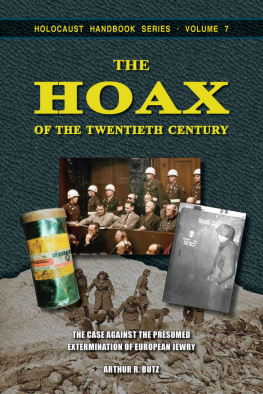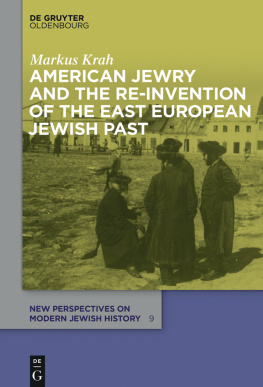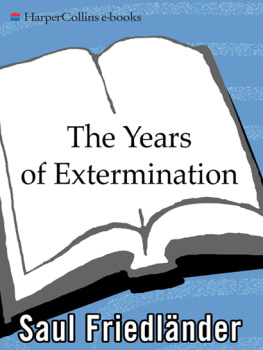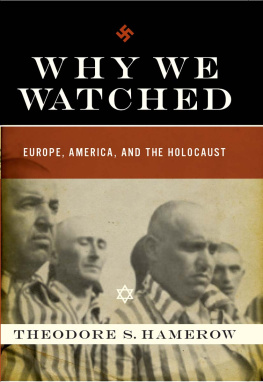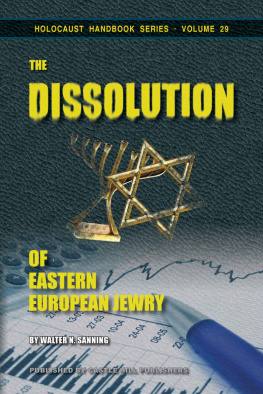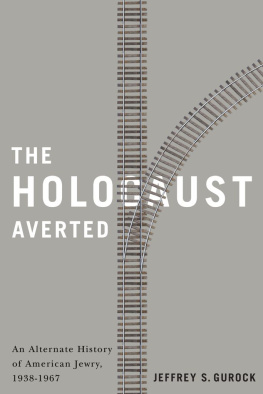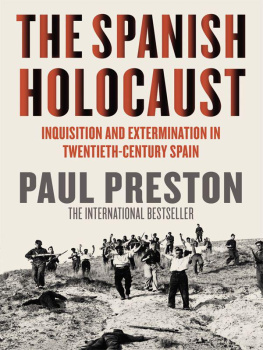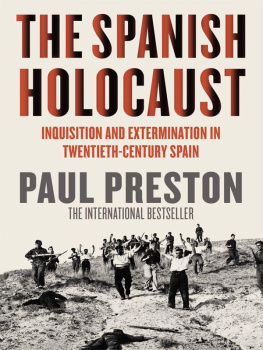The Hoax
of the
Twentieth Century
The Case
Against the Presumed
Extermination of European Jewry
Arthur R. Butz
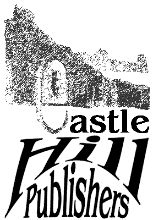
Castle Hill Publishers
P.O. Box 243, Uckfield, TN22 9AW, UK
4th edition, February 2015
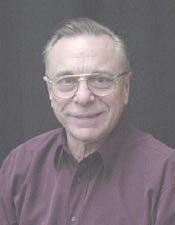
|
The Author Arthur R. Butz was born and raised in New York City. He received his B.S. and M.S. degrees in Electrical Engineering from M.I.T. and his Ph.D. in Control Sciences from the University of Minnesota in 1965. In 1966 he joined the faculty of Northwestern University, Evanston, Illinois, where he is now Associate Professor of Electrical Engineering and Computer Sciences. Dr. Butz is the author of numerous technical papers. |
HOLOCAUST HANDBOOKS, Volume 7:
Arthur R. Butz:
The Hoax of the Twentieth Century.
The Case Against the Presumed Extermination of European Jewry
4th, corrected and expanded edition
Uckfield, East Sussex: Castle Hill Publishers
PO Box 243, Uckfield, TN22 9AW, UK
February 2015
ISBN10: 1-59148-079-5 (print edition)
ISBN13: 978-1-59148-079-2 (print edition)
ISBN13 epub: 978-1-59148-104-1 (electronic edition)
ISSN: 1529-7748
by Arthur R. Butz 1976, 2003, 2015
Distribution worldwide by:
Castle Hill Publishers
P.O. Box 243
Uckfield, TN22 9AW, UK
https://shop.codoh.com
Set in Times New Roman.
www.HolocaustHandbooks.com
Cover illustrations: top: several of the defendants during the Nuremberg Military Tribunal; right: a U.S. soldier in front of a door of a Zyklon B delousing chamber at Dachau concentration camp shortly after the camps liberation; left: a can of the insecticide Zyklon B; background: female members of the staff of the Bergen-Belsen camp carry typhus victims to a mass grave after the camps liberation by the British Army; back cover: another photo of a mass grave of the liberated Bergen-Belsen camp.
Table of Contents
Preface to the 2015 Edition
My investigations of the Jewish Holocaust commenced in 1972, and thirty nine years have passed since the first publication of this book in 1976 in England as The Hoax of the Twentieth Century . Thirty eight years have passed since the release of the slightly revised second British and first American edition of 1977. This text consists of the last, preceded by a short article I wrote for the student newspaper at Northwestern University in 1991 and followed by five supplements representing writings from 1979-2014. There is also an addendum to Appendix E (The Role of the Vatican), consisting of the obituary/tribute I wrote on Rev. Robert A. Graham. All except a late addendum to Supplement 5 were published in the Journal of Historical Review , which ceased publication in 2002. Also Appendix A on Kurt Gerstein, has been revised somewhat.
I am proud that this book remains of interest to anybody almost 40 years after its first publication. Nevertheless, the age of this text, and the great advances that have subsequently occurred in Holocaust revisionism, require some comments on the value of the book to todays reader. How can such an old text not be obsolete today? What does todays reader gain from it? Would it not be better to revise this text to take into account more recent developments?
From the perspective of today, the book has defects, and several people, of whom I am one, could now do better. In admitting such defects, I can plead that I was one man working with little help. Except for Wilhelm Stglich, the correspondents I had before publication in 1976 were not then, and have not subsequently become, significant in revisionist work. The literature of revisionist orientation was scanty. Some of it was rubbish that constituted a minor nuisance. On the positive side were Paul Rassinier, Thies Christophersen , and Wilhelm Stglich. At that time the writings of Rassinier, a former political prisoner at Buchenwald, were of interest both as a primary source, relating personal experiences, and as historical exposition (today Rassinier is of interest only as a primary source). Christophersen and Stglich, Germans who had been stationed near Auschwitz during the war, were of value only as primary sources, although Stglich later wrote a book of historical exposition. Even taking these three into account, the historical complex was not there, as I shall explain below.
A common complaint about this work has been that I am not a trained historian or history professor. It is, however, not unusual for people who are not academic historians to make contributions to historiography. The great American historian Francis Parkman was no history professor; he had only a brief academic appointment as Professor of Horticulture at Harvard. The late Arnaldo Momigliano urged wariness of academic historians and pointed out that none of the three leading nineteenth century historians of the ancient world was a history professor, e.g. Mommsen was a Professor of Law.
However, such examples do not satisfactorily illustrate the fact that history has a closer relationship to popular culture than most other academic disciplines. This is easily clarified and proved. In the major book reviews ( New York Times , New York Review , etc.) one can find reviews of, and advertisements for, many works on the leading edge of historical research, i.e. works not specifically written for popular readership. No such attention is given to leading edge works in electrical engineering and most other academic disciplines. Many intelligent laymen can read such historical works with comprehension. If many can read them, then some can write them. I could give reasons for this relatively popular status of serious history study, but it would carry us too far afield. In any case, there is no venality on the part of academic historians in approving of such popular promotion of their books.
Such observations show, however, that there is hypocrisy in the orthodox historians common implication, when denouncing Holocaust revisionism, that only people with their kinds of Ph.D. degrees are competent to deal with historical issues.
The style of my book is certainly not elegant. I believe my style has improved much since then but, like most men with a technical education, my style remains at best dry and not elegant. It was, however, good enough to do the job. I have even sometimes wondered if elegance of style might be incompatible with a subject as dreary as the present one.
It is not immodest for me to say that mine is the best book of its type, because it is the only book of its type. To compare my book to others, the approach of mine is horizontal, the others vertical. Subsequent investigators have taken specific subjects and gone more deeply into them than I did. Such vertical approaches should be contrasted with my horizontal. I attempted to cover every reasonably relevant aspect of the problem. The question of the existence of homicidal gas chambers was only one of many. I tried to show what did happen as well as what did not. I showed the relevance of the Zionist and related movements. I discussed the Allied policies and the Jewish influences in them. My use of sources ( e.g. the Nuremberg trials, Red Cross reports, Vatican documents, contemporary newspaper accounts) today seems obvious but it was not then. To aid in comprehending the early war crimes trials, I gave witchcraft trials as a useful precedent.
I claim an additional contribution of this book that may seem ridiculous on its face. I treated the German concentration camps as specific institutions that existed in specific locations, with the alleged events that took place in them taking place, if at all, in real space and real time, together with other events that happened simultaneously in those same camps or in real space. By real space I mean a space that we all exist in so that, whatever happened at Auschwitz, it happened at the same time President Roosevelt held meetings in Washington, and I as a child went to school, etc., and in the same space.

